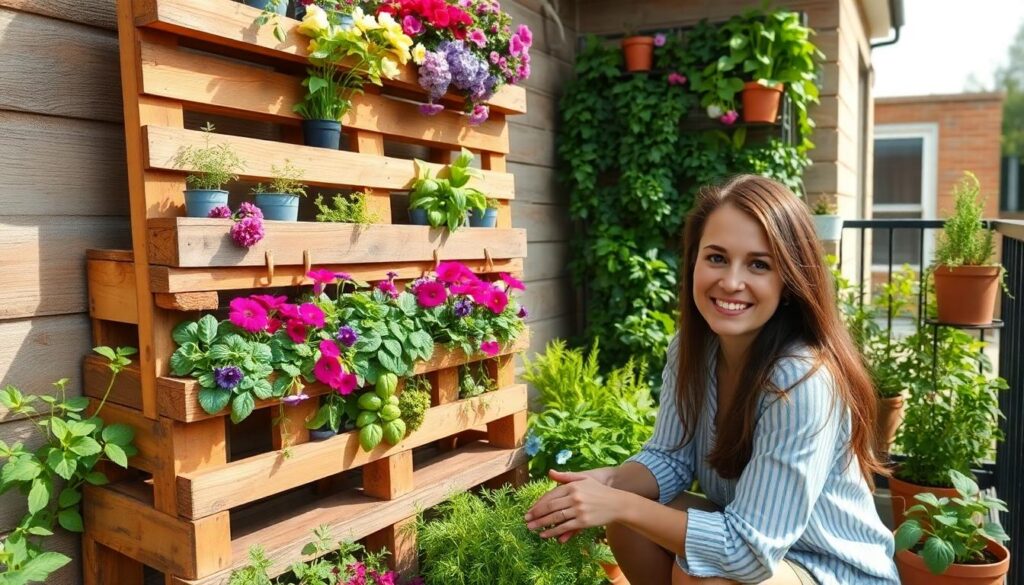Looking for creative gardening answers without very costly? Pallet gardens offer the perfect blend of sustainability, style, and simplicity. We’ve discovered that these versatile wooden structures can transform even the smallest spaces into flourishing green sanctuaries.
Whether you’re working with a tiny balcony, limited yard space, or just want to add vertical interest to your garden, pallets provide endless possibilities. From vertical herb gardens that spice up your cooking to stunning flower displays that brighten any outdoor area, we’ll show you how to repurpose these wooden platforms into gorgeous, functional garden spaces. Join us as we explore innovative pallet garden ideas that combine practicality with eco-friendly design.
10 Creative Pallet Garden Ideas That Maximize Your Space
1. Vertical Herb Garden
Create a space-saving vertical herb garden using a single pallet mounted on any wall. Simply sand the pallet, add a protective finish, attach industry fabric to the back, and fill with herb-friendly soil. Plant your favorite culinary herbs like basil, mint, rosemary, and thyme in different sections. This setup works wonderfully in small patios or kitchen walls where you can easily snip fresh herbs while cooking.
2. Tiered Flower Display
Transform multiple pallets into a striking tiered flower display that adds dimension to flat outdoor spaces. Stack pallets in a pyramid formation, securing each level with strong brackets. Fill the openings with colorful annual flowers like petunias, marigolds, and verbena. This display makes a perfect focal point for patios or entryways while utilizing vertical space effectively.
3. Hanging Succulent Wall
Create a stunning living wall by mounting a pallet horizontally and filling the slats with drought-resistant succulents. Add chicken wire to the back of each opening to hold soil in place while allowing proper drainage. Succulents require minimal watering and maintenance, making this an ideal option for busy gardeners with limited space.
4. Rolling Garden Cart
Build a mobile garden cart by attaching wheels to the bottom of a sturdy pallet. Add sides using additional pallet boards, creating a deep planter box perfect for vegetables or flowers. The mobility allows you to chase sunlight throughout the day or move your garden during extreme weather conditions, maximizing growing potential in restricted spaces.
5. Strawberry Planter Tower
Construct a vertical strawberry planter using pallets arranged in a box formation. Create multiple planting pockets by stapling industry fabric inside each slat opening. The vertical design allows strawberry plants to cascade downward, keeping fruits off the ground and preventing rot. This tower can produce dozens of strawberry plants in just four square feet of ground space.
6. Privacy Screen with Climbing Plants
Design a beautiful living privacy screen by standing several pallets upright in a row. Secure them firmly in the ground or on your deck, then plant climbing vines like jasmine, clematis, or morning glories at the base. The plants will naturally climb the wooden structure, creating a fragrant, colorful screen that offers both beauty and privacy for small outdoor living areas.
7. Sectioned Vegetable Garden
Create a compact vegetable garden using a pallet laid flat on the ground with raised edges. Divide the interior into sections using additional pallet boards to separate different vegetable varieties. This organization prevents aggressive plants from taking over while maximizing growing space. Plant complementary vegetables together, such as tomatoes with basil or carrots with onions.
8. Vertical Tool Organizer
Mount a pallet vertically near your garden area to store and organize garden tools. Add hooks of various sizes to hang trowels, pruners, gloves, and watering cans. Install small shelves between slats to hold seed packets, plant markers, and small pots. This practical solution keeps gardening supplies accessible while freeing up valuable ground space.
9. Pallet Potting Bench
Construct a space-efficient potting bench using one or two pallets. Stand one pallet vertically for the back, attaching another horizontally as the workspace. Add shelving below for storing pots and soil bags. This compact workstation provides a dedicated area for repotting plants and starting seeds without requiring the space of a traditional potting bench.
10. Mini Greenhouse
Transform pallets into a compact greenhouse by creating a box frame and covering it with clear plastic or old windows. Design the structure with a hinged top for easy access to plants inside. This mini greenhouse extends your growing season by protecting seedlings from frost and harsh weather while taking up minimal space on a patio or deck.
Vertical Pallet Herb Gardens for Small Spaces
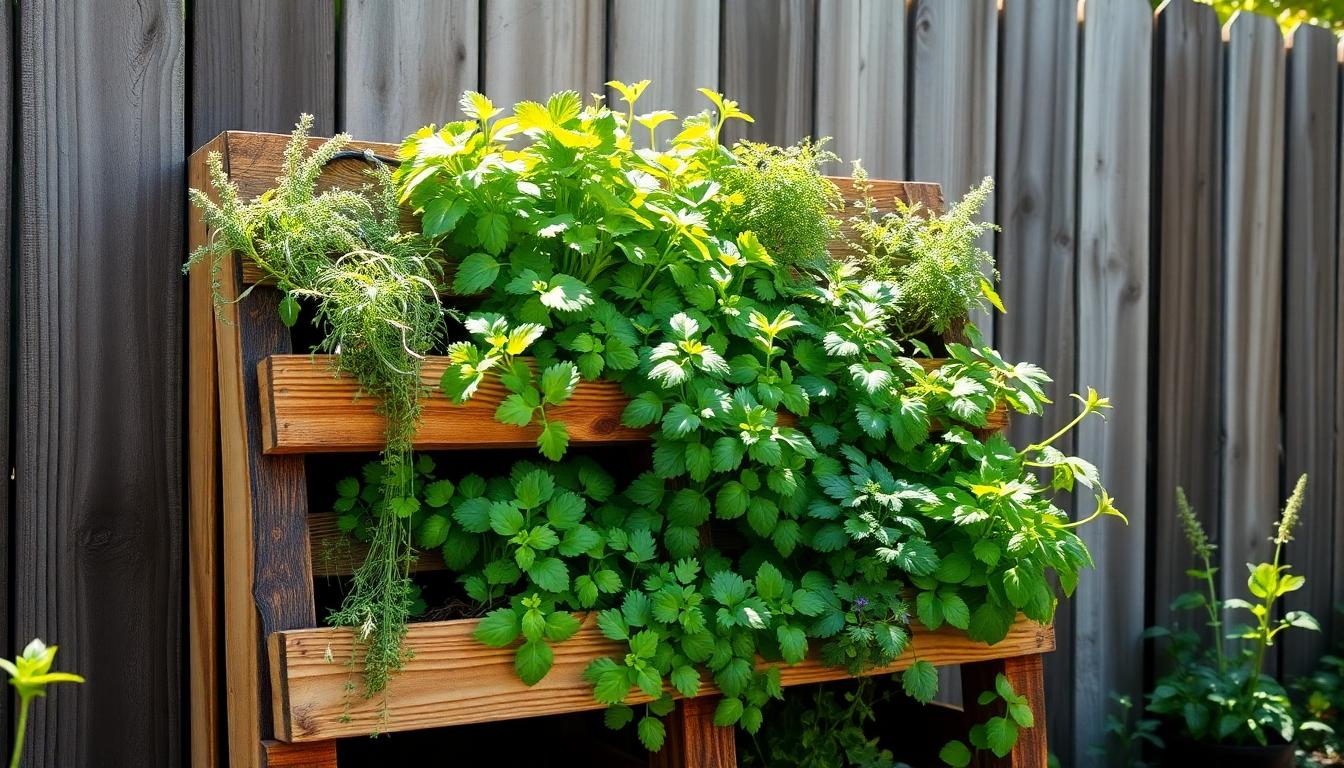
Pallet gardens offer a brilliant solution for herb cultivation in compact areas. By repurposing wooden pallets into vertical planters, you’ll maximize growing space while adding a rustic charm to walls or fences. These space-saving gardens require minimal floor space yet provide ample room for a variety of culinary and aromatic herbs.
Essential Herbs to Grow in Your Vertical Pallet
Thyme thrives in vertical pallet gardens due to its low maintenance nature and ability to grow in shallow soil conditions. Its compact growth habit makes it perfect for the limited space between pallet slats.
Parsley grows quickly in pallet gardens and rewards you with abundant harvests when regularly pruned. This versatile herb adapts well to the vertical growing environment while providing fresh flavor for countless dishes.
Oregano performs exceptionally well in the slightly confined spaces of pallet planters. Its sprawling growth habit allows it to cascade attractively from the wooden structure.
Mint requires careful placement in your pallet garden due to its vigorous growing tendencies. Consider isolating mint in its own section to prevent it from overwhelming neighboring herbs.
Chives demand minimal care while producing beautiful purple blooms and flavorful stems. Their upright growth pattern works perfectly within the vertical orientation of pallet gardens.
Cilantro adapts well to pallet growing conditions when given adequate moisture and some afternoon shade. Regular harvesting encourages continued production throughout the growing season.
Tarragon offers distinctive anise-like flavor from a relatively compact plant that fits nicely in pallet garden slots. Its perennial nature means years of harvests from a single planting.
Watering and Maintenance Tips for Vertical Herb Gardens
Apply water gently to prevent soil erosion from the pallet structure. Small-stream watering cans or drip irrigation systems work best for delivering moisture without washing away soil.
Ensure proper drainage by adding drainage holes if your pallet design tends to trap water. Waterlogged soil quickly leads to root rot and herb failure in the confined pallet environment.
Position your pallet garden to receive morning sunlight with afternoon shade for optimal herb growth. Most culinary herbs prefer this light pattern, especially in warmer climates.
Use organic potting soil specifically formulated for containers to promote healthy herb development. Quality soil provides essential nutrients and proper moisture retention in the limited growing space.
Prune herbs regularly to encourage bushy growth rather than leggy stems. Consistent harvesting not only provides fresh herbs for cooking but also maintains compact plant shapes ideal for pallet gardens.
Monitor soil moisture more frequently than in-ground gardens since pallet planters can dry out quickly. The vertical orientation and exposed sides of pallet gardens increase evaporation rates.
Fertilize lightly but consistently throughout the growing season with organic herb fertilizer. The restricted root space in pallet gardens means nutrients deplete more rapidly than in traditional gardens.
Horizontal Pallet Planters for Flowers and Vegetables
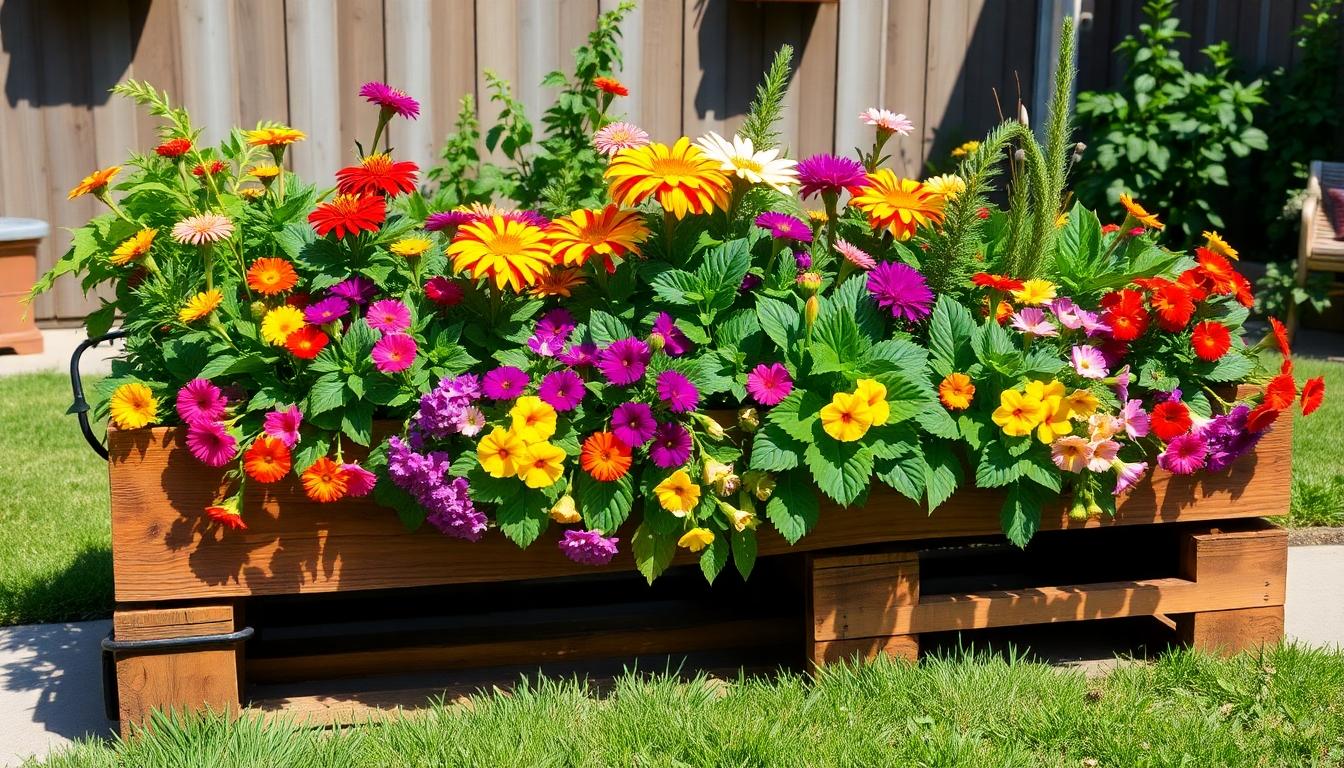
Horizontal pallet planters transform ordinary wooden shipping materials into efficient garden beds with built-in compartments. These versatile structures provide excellent platforms for growing both decorative flowers and nutritious vegetables in a space-saving layout.
Selecting the Perfect Flowers for Your Pallet Garden
Annual flowers with shallow root systems thrive exceptionally well in horizontal pallet planters. Pansies and petunias make fantastic choices due to their compact growth habits and brilliant colors. Succulents represent another excellent option for pallet gardens since their minimal root depth requirements align perfectly with the planter’s limited soil volume. When planning your pallet flower garden, consider mixing different textures and heights to create visual interest while maintaining practical growing conditions. Water requirements should factor into your plant selection process, as pallet planters typically offer improved drainage compared to traditional garden beds.
Growing Vegetables in Horizontal Pallet Beds
Horizontal pallet beds create ideal growing environments for a variety of compact and shallow-rooted vegetables. Microgreens flourish in these structures, providing quick harvests and nutritional benefits within the confined spaces. Leafy greens including lettuce, spinach, kale, and arugula perform remarkably well in pallet beds due to their modest root requirements. The elevated design of pallet planters significantly improves drainage while simultaneously reducing weed competition, making maintenance substantially easier than ground-level gardening. Soil quality remains completely under your control in these contained systems, allowing precise nutrient management for optimal vegetable production. Root vegetables with compact growth habits can also succeed in deeper pallet configurations, expanding your cultivation options beyond just leafy varieties.
Pallet Garden Walls That Transform Your Outdoor Space

Pallet garden walls offer an innovative solution for maximizing your outdoor space while adding visual interest. These versatile structures can transform plain walls into lush, living displays that enhance any garden setting.
Installing a Living Pallet Wall Step-by-Step
- Gather necessary materials – You’ll need 6-8 wooden pallets, sturdy 4×4 posts for support, exterior-grade screws, and a framework to ensure stability. Select pallets that are in good condition and free from chemical treatments.
- Create a solid foundation – Position your 4×4 posts in the desired location, ensuring they’re firmly secured in the ground to provide adequate support for your wall structure.
- Attach pallets securely – Connect the pallets to the posts using exterior screws, making sure each connection is sturdy enough to withstand weather conditions and the weight of plants.
- Prepare planting pockets – Line each pallet pocket with plastic bags or industry fabric to prevent soil from leaking out. Don’t forget to add drainage holes to ensure proper water flow and plant health.
- Add quality growing medium – Fill each pocket with nutrient-rich compost mixed with regular potting soil to provide the best environment for your plants to thrive.
- Install irrigation – Consider adding a drip irrigation system to ensure consistent watering, particularly important for vertical structures where water tends to drain quickly.
Plant Selection for Thriving Pallet Walls
- Herbs for culinary gardens – Aromatic herbs like thyme, rosemary, and sage thrive in vertical pallet walls and require minimal maintenance while providing fresh ingredients for cooking. These plants adapt well to the shallow soil conditions found in pallet pockets.
- Succulents for low-maintenance displays – Drought-tolerant succulents create striking visual patterns and require little water once established. Their compact growth habit makes them ideal candidates for vertical garden spaces.
- Flowering plants for visual impact – Select flowering varieties that match your climate conditions and desired color scheme. Petunias, pansies, and marigolds add vibrant splashes of color to transform an ordinary wall into a stunning focal point.
- Leafy vegetables for edible walls – When your pallet wall receives adequate sunlight, consider planting spinach, lettuce, and other leafy greens for a productive and attractive display. These vegetables grow well in the confined spaces of pallet pockets.
- Trailing plants for cascading effects – Incorporate vining plants like ivy, trailing petunias, or sweet potato vine to create dramatic cascading effects that soften the geometric lines of the pallet structure.
Standalone Pallet Planters for Patios and Decks
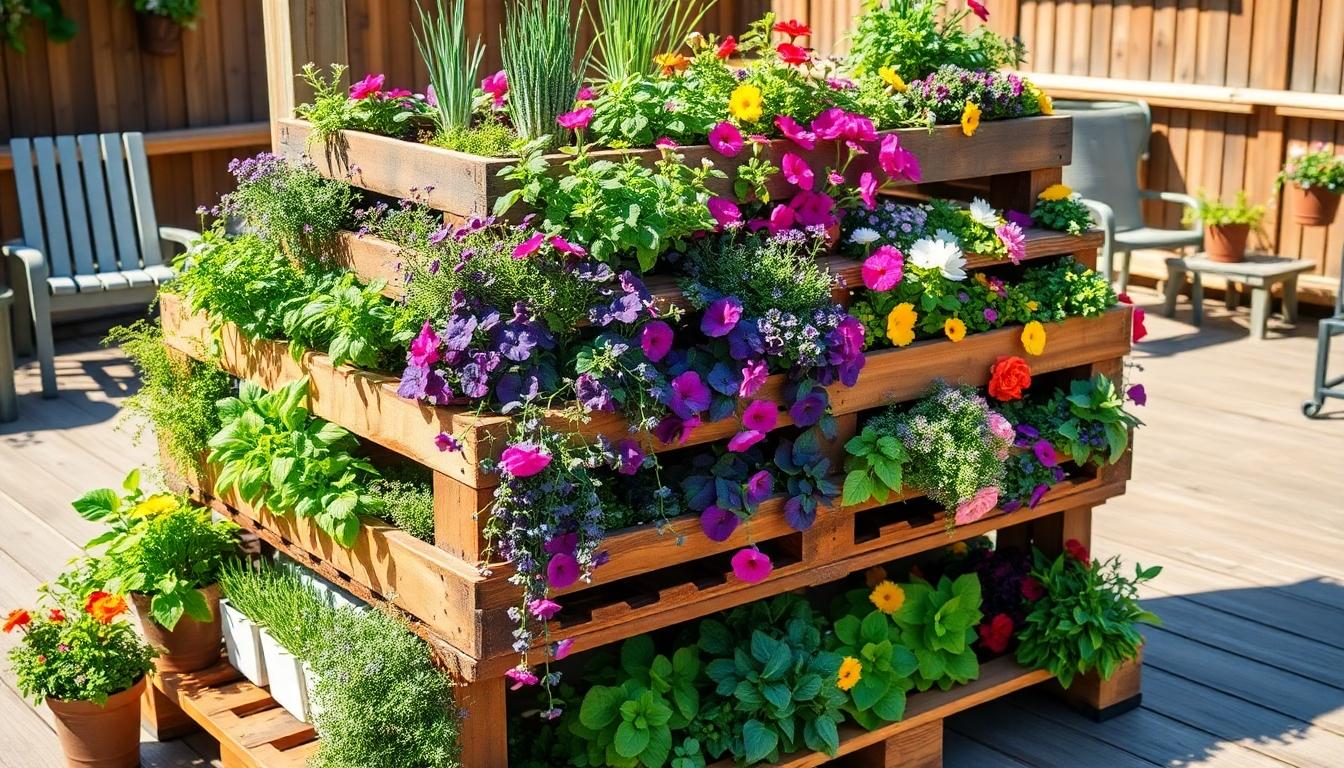
Transforming intact pallets into freestanding planters offers a practical solution for adding greenery to your outdoor spaces. These versatile structures can be easily customized to fit any patio or deck layout while providing ample growing space for various plants. Start by selecting heat-treated pallets (marked with “HT”) to ensure they’re free from harmful chemicals, especially important when growing edibles. Line the gaps between slats with industry fabric, fill with quality soil, and plant your favorite herbs, flowers, or vegetables. Securing your planters to patio surfaces or adding legs using salvaged wood will provide additional stability, while the raised design naturally improves drainage and reduces weed problems.
Creating Multi-Tiered Pallet Displays
Multi-tiered pallet arrangements maximize growing space while creating visually stunning garden displays for your outdoor area. Stack pallets either horizontally or vertically, securing them with hinges or brackets to ensure stability and safety. Vertical arrangements work exceptionally well for small spaces, effectively transforming limited square footage into productive growing areas. These tiered structures create perfect growing conditions for cascading plants like strawberries or trailing flowers that can spill over the edges dramatically. Popular designs on Pinterest showcase herb gardens with staggered shelves and integrated pot holders, offering both functionality and style. Advanced setups can incorporate trellises for climbing plants such as beans or cucumbers, further expanding your growing options in the same footprint.
Weatherproofing Your Pallet Planters
Protecting your pallet planters from the elements ensures they’ll serve your garden needs for multiple seasons. Apply non-toxic, water-based sealants to shield the wood from moisture damage and harmful UV rays that can cause premature deterioration. Sanding rough edges not only improves the planter’s appearance but also prevents painful splinters during gardening activities. For exposed locations, select weather-resistant plants like succulents or drought-tolerant herbs such as rosemary that can withstand challenging conditions. Elevate your planters slightly off the ground to prevent direct contact with moisture that accelerates rot, and promptly replace any damaged or rotting slats to maintain structural integrity. Lining planter interiors with plastic (punctured for essential drainage) significantly reduces soil erosion while protecting the wood from constant moisture exposure, extending the life of your garden feature considerably.
Pallet Succulent Gardens for Low-Maintenance Beauty
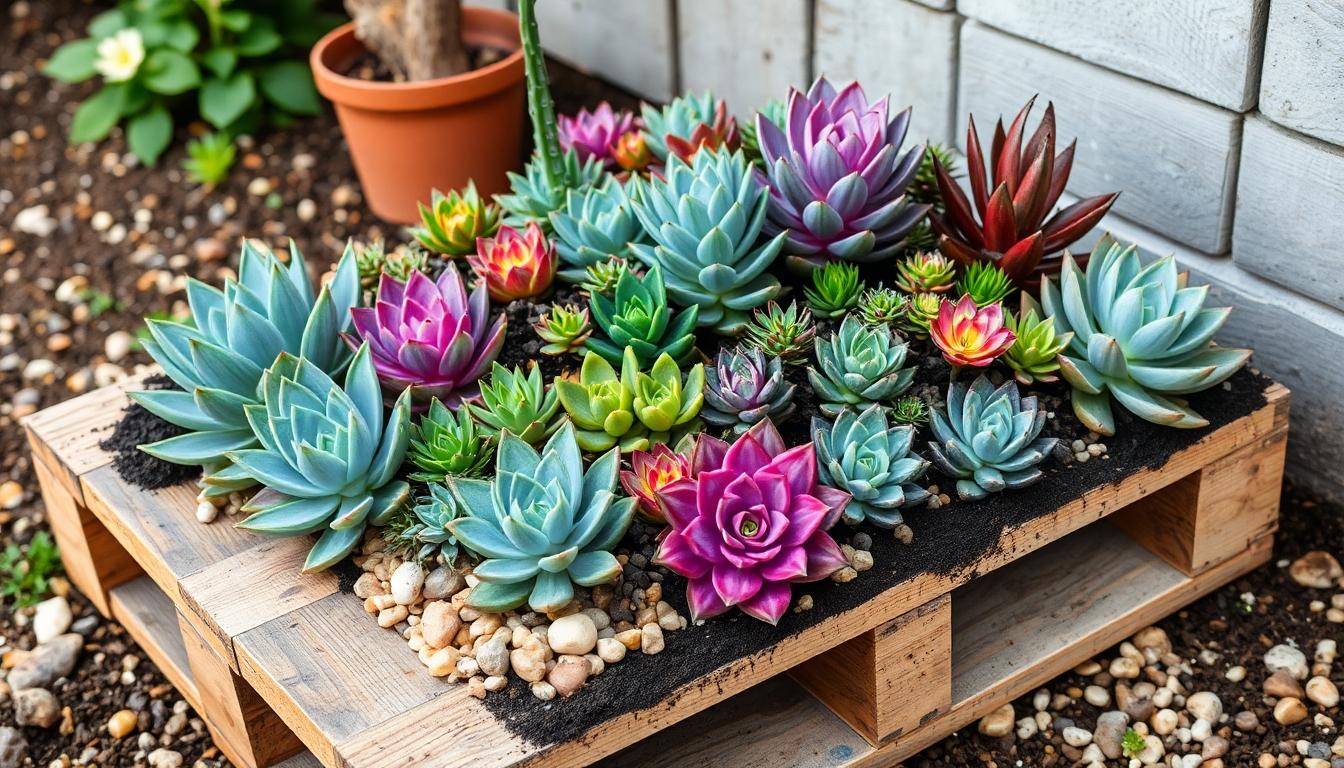
Transforming wooden pallets into succulent gardens creates an eye-catching display that requires minimal upkeep while maximizing visual impact. Succulents are perfect candidates for pallet gardening due to their drought tolerance and ability to thrive in shallow soil conditions with proper drainage.
Best Succulents for Pallet Garden Arrangements
Aloe vera stands out as an excellent choice for pallet gardens, offering both ornamental appeal and practical healing properties in a compact growing form. Echeveria varieties bring stunning rosette formations in an array of colors from blue-green to purple, creating focal points throughout your arrangement. Jade plants (Crassula) thrive in the confined spaces of pallet gardens, developing into lush miniature tree-like structures with minimal care requirements. Selecting a variety of succulents with different heights, textures, and colors will create a ever-changing visual composition that evolves beautifully over time. Many growers find that mixing trailing varieties like String of Pearls with upright selections like Haworthia creates depth and dimension in pallet arrangements. We recommend grouping succulents with similar water and light requirements together to simplify maintenance and ensure all plants receive appropriate care.
Proper Drainage Techniques for Succulent Pallets
Creating optimal drainage conditions is essential for succulent pallet success, as these plants are particularly susceptible to rot from excess moisture. Drill multiple drainage holes along the bottom and sides of your pallet to ensure water can escape freely after watering sessions. Using specialized cactus and succulent potting mix provides the well-draining foundation these plants require, preventing water retention that could damage delicate root systems. Adding a layer of gravel or perlite enhances drainage further by creating air pockets that allow roots to breathe and excess water to move away quickly. Positioning your pallet at a slight angle can promote better water flow and prevent pooling in any one section of the arrangement. Some gardeners line their pallets with industry fabric to contain soil while still allowing moisture to escape through the drainage holes. We’ve found that applying a thin layer of decorative pebbles on the soil surface not only enhances the visual appeal but also improves drainage by reducing soil compaction when watering.
Pallet Strawberry Planters for Delicious Harvests
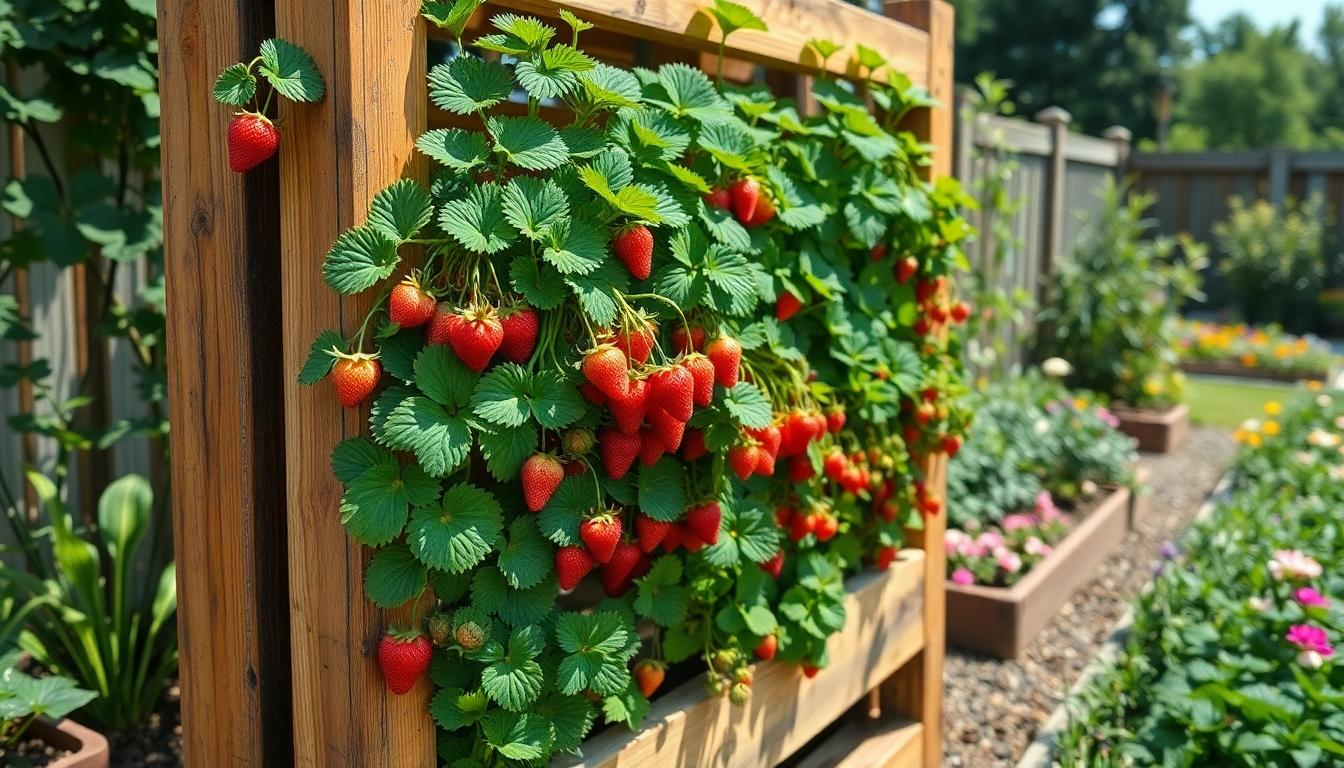
Pallet strawberry planters offer an ingenious way to grow sweet berries while maximizing limited garden space. These versatile structures can transform unused wooden pallets into productive growing spaces that yield delicious harvests throughout the season.
Vertical Gardens
Vertical pallet gardens provide an excellent solution for growing strawberries in small spaces. By positioning plants vertically, you’ll maximize your growing area while creating easy access points for harvesting ripe berries. The vertical orientation also improves air circulation around plants, reducing disease issues common in dense plantings.
Pallet Planter Construction
Building a strawberry pallet planter requires minimal materials and basic DIY skills. Start by disassembling a heat-treated pallet, then use the planks to create a sturdy frame that will support your plants. Fill the structure with high-quality potting soil specifically formulated for berries, ensuring plants have adequate growing medium. Position your strawberry plants at regular intervals to allow for proper growth and development.
Irrigation
Proper irrigation plays a crucial role in successful strawberry pallet gardens. Install a drip irrigation system to deliver consistent moisture directly to plant roots without wetting foliage. Ensure your pallet planter has adequate drainage holes to prevent waterlogging, which can lead to root rot and poor fruit development.
Maximizing Berry Production in Pallet Gardens
Sunlight access significantly impacts strawberry yields in pallet gardens. Position your structure where it receives 6-8 hours of direct sunlight daily for optimal fruit production. Plants that receive insufficient light typically produce fewer, smaller berries with less flavor development.
Soil quality directly affects both plant health and berry flavor. Use well-draining, nutrient-rich soil mixtures that retain adequate moisture while allowing excess water to escape. Incorporate compost or organic matter to improve soil structure and provide essential nutrients throughout the growing season.
Proper spacing between strawberry plants prevents competition for resources and promotes robust growth. Allow approximately 8-10 inches between plants to ensure each one receives adequate light, water, and nutrients. Appropriate spacing also improves air circulation, reducing humidity levels that can lead to fungal diseases.
Preventing Pests in Your Strawberry Pallet
Organic pest control methods provide effective protection without introducing harmful chemicals to your edible garden. Apply neem oil or insecticidal soap to manage common strawberry pests like aphids and slugs. These natural answers target harmful insects while preserving beneficial garden creatures that help with pollination and pest management.
Physical barriers offer simple yet effective protection for your strawberry plants. Install fine mesh screens around your pallet garden to prevent insects, birds, and other pests from accessing your plants and fruits. Raised pallet designs naturally deter ground-dwelling pests like slugs and certain insects.
Crop rotation strategies help prevent pest populations from becoming established in your garden. Move your strawberry pallet to a different location every couple of years to break pest life cycles and reduce disease pressure. This practice also allows soil to recover between strawberry plantings, ensuring optimal growing conditions for future harvests.
Upcycled Pallet Compost Bins for Garden Sustainability

Transforming old pallets into functional compost bins represents one of the most practical and eco-friendly garden projects you can undertake. These structures not only help reduce waste but also create nutrient-rich soil amendments that will dramatically improve your garden’s health and productivity.
Building Your First Pallet Compost System
Creating a compost bin from pallets requires minimal materials and offers maximum sustainability benefits. You’ll need several pallets, some wire or fencing material for the sides, and a cover such as a lid or tarp to control moisture. Start by collecting four to six sturdy pallets that will form the structure of your bin. Arrange four pallets to create a square or rectangular shape, securing the corners firmly with wire or strong twine. For additional stability, drive stakes into the ground at each corner of your structure. Attach fencing material to any open sides to prevent compost from falling out while still allowing airflow. Finally, place another pallet on top or use a tarp as a cover to maintain proper moisture levels and heat within your compost pile.
Maintaining Healthy Compost in Pallet Structures
Successful composting in your pallet bin depends on maintaining the right balance of materials and conditions. Add carbon-rich “browns” such as dry leaves, straw, or shredded paper to provide structure and energy for microorganisms. Balance these with nitrogen-rich “greens” including kitchen scraps, grass clippings, and manure to accelerate decomposition. Monitor moisture levels regularly, aiming for the consistency of a wrung-out sponge—damp but not soggy. Turn your compost every few weeks using a garden fork to incorporate oxygen, which speeds up the decomposition process and prevents unpleasant odors. Pay attention to temperature fluctuations, as a properly functioning compost pile should heat up to indicate active microbial breakdown. During colder months, insulate your pallet bin with straw bales or bubble wrap to maintain decomposition activity. Your finished compost will be dark, crumbly, and earthy-smelling, ready to enrich your pallet gardens with essential nutrients.
Decorative Pallet Garden Borders and Pathways
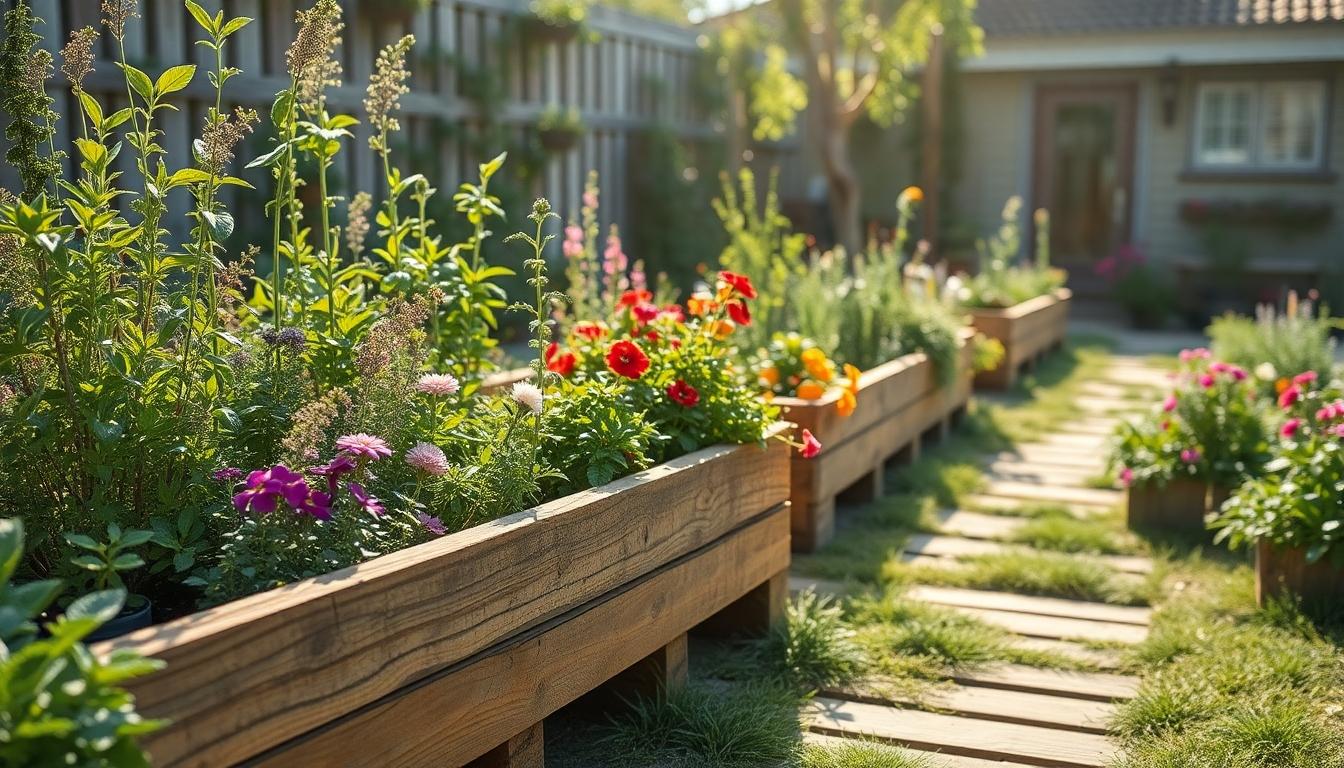
Creating Rustic Garden Boundaries with Pallets
Repurposed wood pallets offer an excellent eco-friendly and cost-effective solution for defining garden spaces. We’ve found that pallets can be stacked either horizontally or vertically to create distinctive raised edges around flower beds and vegetable plots. Securing these structures with stakes or posts ensures they remain firmly in place throughout the seasons. Many gardeners achieve an attractive tiered effect by arranging pallets in a staggered formation, filling the gaps with nutrient-rich soil that’s perfect for planting cascading herbs like thyme or trailing flowers. This technique transforms ordinary garden boundaries into functional growing spaces while maintaining a charming rustic aesthetic. The natural wood appearance complements various garden styles, from cottage gardens to more contemporary outdoor spaces.
Incorporating Pallet Walkways into Your Industry
Dismantled pallet planks create stunning wooden pathways that guide visitors through your garden with rustic charm. Sanding the planks thoroughly prevents splinters and ensures safe passage for bare feet during summer months. These versatile boards can be laid directly on prepared soil or a gravel base for a simple ground-level walkway. Elevated designs require attaching planks to intact pallet frames using weather-resistant screws, with strategic spacing between slats to promote proper drainage during rainy periods. Applying a quality weatherproof finish significantly extends the lifespan of your pallet pathways by protecting the wood from moisture, UV damage, and insect infestation. Pallet walkways integrate beautifully with other garden elements, creating cohesive design flow while providing practical access to different garden zones.
Additional pallet applications enhance garden functionality through structures like open-air compost bins constructed by stacking pallets vertically and securing corners with durable zip ties or metal brackets. Vertical planters mounted on walls or fences create space-efficient homes for herbs such as parsley and basil or colorful flowers like pansies. Foldable trellises formed by hinging two pallets at the top provide ideal support for vining vegetables including cucumbers and beans.
For all garden projects, we strongly recommend using only heat-treated (HT) pallets for growing edible plants. Always avoid pallets marked with “MB” (indicating methyl bromide treatment) or those with colored stains that might signal chemical contamination, especially when creating structures for food-producing plants.
Movable Pallet Gardens for Changing Sunlight Conditions
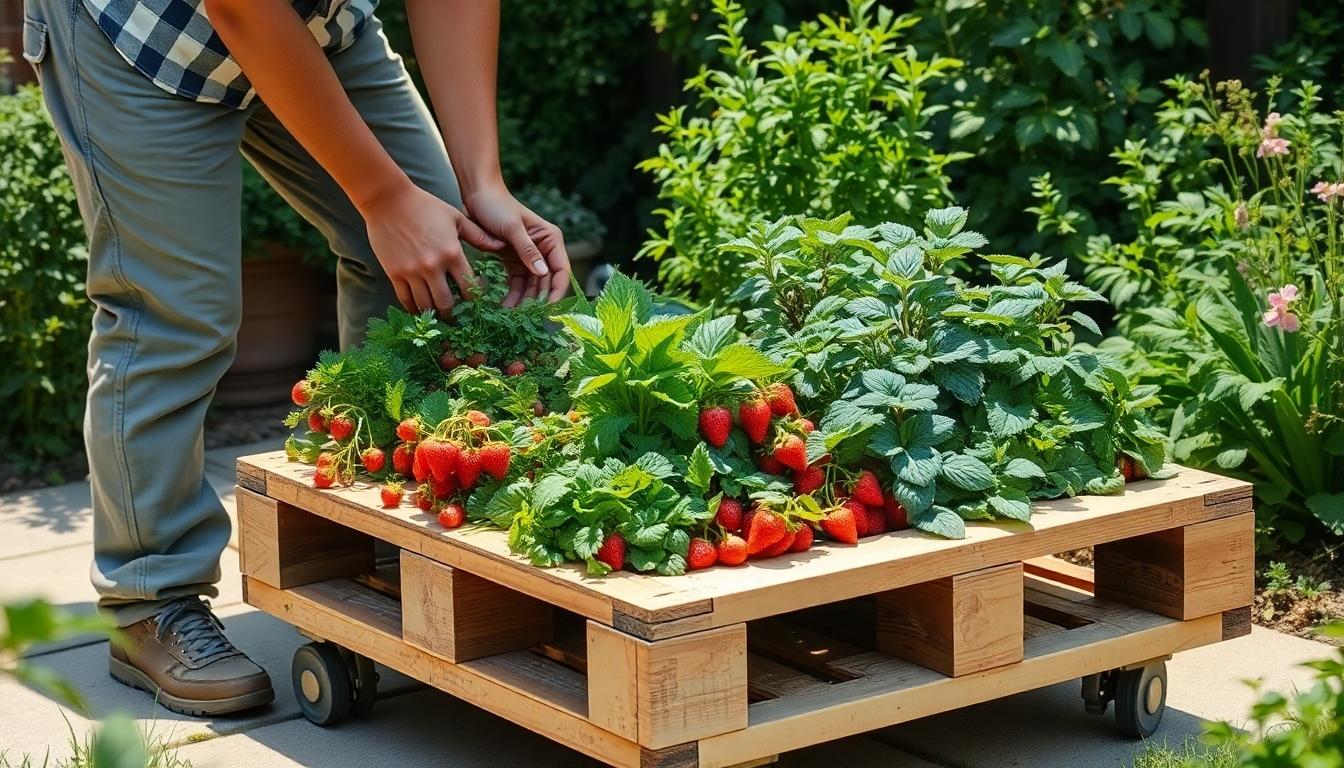
Movable pallet gardens offer an ingenious solution for plants that need exact light conditions throughout the day or seasons. We’ve found that these portable gardens allow you to optimize sunlight exposure by simply relocating your plants as needed. Vertical designs, particularly herb gardens with chalkboard labels, provide lightweight and mobile options that work perfectly in changing environments. For best results, always select untreated or heat-treated pallets when growing edibles, and secure your plants either in modular containers or directly within the pallet slats for stability during movement.
Plants That Thrive in Mobile Garden Settings
Herbs dominate the list of plants that excel in mobile pallet gardens due to their adaptable nature and shallow root systems. Basil, thyme, and parsley consistently perform well in these transportable environments, requiring minimal soil depth while offering maximum flavor. Microgreens provide another excellent option, growing quickly and allowing frequent harvests from your movable garden setup. Strawberries thrive particularly well in mobile settings, with their compact growth habit making them perfect candidates for pallet gardening. Compact vegetables like lettuce and spinach adapt beautifully to changing locations, allowing you to adjust their position based on seasonal sun patterns. Vining plants such as cucumbers, pole beans, and tomatoes can also succeed when grown on trellis-modified pallets, though they may need additional stabilization when moving the structure. Fast-growing annuals generally outperform perennials in mobile gardens, offering the flexibility to make seasonal adjustments without disrupting long-term plant development.
Caster Wheel Options for Transportable Pallet Gardens
Swivel casters represent the optimal choice for movable pallet gardens, providing 360-degree maneuverability that makes repositioning effortless throughout the day. Models featuring locking mechanisms with rubber tread offer the best combination of mobility and stability, preventing unwanted movement once positioned. Heavy-duty wheels prove essential for soil-filled pallets, with each caster needing to support at least 50 pounds to accommodate the substantial weight of soil, plants, and water. Corrosion-resistant materials like polyurethane or galvanized steel withstand outdoor conditions better than standard casters, extending the lifespan of your mobile garden system. Proper mounting requires attaching wheels directly to the pallet base using sturdy brackets, creating a stable foundation. Even weight distribution across all casters prevents tipping hazards, especially with taller vertical garden designs. When selecting wheels for your project, prioritize appropriate load capacity, terrain compatibility for your exact outdoor space, and weather resistance based on your garden’s size and weight.
Preparing and Treating Pallets for Safe Garden Use
Pallet gardens offer endless possibilities for transforming ordinary outdoor spaces into thriving green havens. Whether you’re working with a tiny balcony or a modest backyard these wooden wonders can be reimagined as vertical herb gardens succulent displays or even mobile planting stations.
We’ve explored many creative approaches from space-saving vertical walls to practical tool organizers and decorative garden borders. The versatility of pallets makes them perfect for growing everything from culinary herbs and strawberries to colorful flowers and nutritious vegetables.
By repurposing these wooden structures we’re not just creating beautiful gardens we’re also embracing sustainability and eco-friendly gardening. With some creativity basic tools and a few pallets you’ll be well on your way to developing a unique garden that maximizes your space while minimizing your environmental footprint.
Frequently Asked Questions
What is a pallet garden?
A pallet garden is a creative and sustainable gardening solution made from repurposed wooden shipping pallets. These versatile structures can be transformed into vertical gardens, horizontal planters, garden walls, or movable garden beds. They’re perfect for small spaces like balconies or limited yards, allowing you to grow herbs, flowers, vegetables, or succulents in a space-efficient and eco-friendly way.
Are pallet gardens safe for growing edibles?
Yes, but only when using the right pallets. Always choose untreated or heat-treated (HT) pallets for growing edibles. Avoid chemically treated pallets (marked MB for methyl bromide) as they contain harmful chemicals that can leach into soil and plants. Clean pallets thoroughly before use and consider lining them with landscape fabric as an additional barrier between the wood and your soil.
Which herbs grow best in vertical pallet gardens?
The best herbs for vertical pallet gardens include thyme, oregano, mint, chives, cilantro, parsley, and tarragon. These herbs adapt well to vertical growing conditions, tolerate partial shade, and have shallow root systems. Most are also perennial or self-seeding, providing harvests for multiple seasons. Position sun-loving varieties like rosemary and thyme at the top of your vertical garden where they’ll receive maximum sunlight.
How do I ensure proper drainage in pallet gardens?
Ensure proper drainage by drilling additional holes in the pallet boards where water might collect. Line the back of vertical gardens with landscape fabric, leaving the bottom open. For horizontal planters, create a slight tilt for water runoff. Use well-draining potting mix rather than garden soil, and add perlite or coarse sand to improve drainage. For succulent gardens, incorporate specialized cactus soil to prevent root rot.
Can I grow vegetables in pallet gardens?
Absolutely! Horizontal pallet planters work well for compact vegetables like lettuce, spinach, radishes, and herbs. Deeper configurations can support shallow-rooted vegetables like carrots and beets. Vertical pallet gardens can accommodate leafy greens and compact varieties like cherry tomatoes or bush beans. Ensure your vegetables receive adequate sunlight (at least 6 hours daily) and proper watering. Movable pallet gardens are ideal for optimizing sunlight exposure throughout the season.
How do I make a pallet garden mobile?
Create a mobile pallet garden by attaching heavy-duty swivel casters to the bottom of your pallet. Choose casters with locking mechanisms for stability when parked. Mount wheels at all four corners, ensuring even weight distribution, and reinforce the pallet base if necessary. Opt for lightweight designs—vertical herb gardens or shallow planters work best. Mobile gardens allow you to chase sunlight, protect plants from harsh weather, and easily rearrange your outdoor space.
What are the best plants for pallet garden walls?
For pallet garden walls, choose plants based on your wall’s location and purpose. Culinary herb walls thrive with rosemary, thyme, and sage. For low-maintenance displays, use drought-tolerant succulents like sedums and echeverias. Flowering plants such as petunias and calibrachoa create visual impact. Edible walls work well with leafy greens like lettuce and spinach. Add trailing plants such as creeping thyme or string of pearls for cascading effects that soften the structure.
How do I care for a pallet succulent garden?
Care for pallet succulent gardens by placing them in locations receiving 4-6 hours of sunlight daily. Water sparingly—only when the soil is completely dry, typically every 2-3 weeks depending on climate. Use well-draining cactus soil and ensure proper drainage holes. Remove dead leaves promptly to prevent rot and pests. Protect from frost in winter, and fertilize lightly with cactus fertilizer during the growing season. Most succulents thrive on neglect rather than excessive attention.
How can I grow strawberries in a pallet planter?
Create a strawberry pallet planter by standing a pallet upright, lining it with landscape fabric, and filling with quality potting soil. Plant strawberry runners in the spaces between slats, spacing them 8-10 inches apart. Ensure 6+ hours of sunlight daily and consistent moisture. Install a drip irrigation system for even watering. Protect berries from birds with netting, and control pests organically. Rotate planting areas every 2-3 years for optimal production and disease prevention.
How long do pallet gardens last?
With proper preparation and maintenance, pallet gardens typically last 2-5 years outdoors. Extend their lifespan by using hardwood pallets, applying non-toxic weather-resistant sealants, elevating structures off the ground, and installing proper drainage. Regular maintenance—tightening loose boards, replacing rotted sections, and resealing annually—prevents premature deterioration. In wet climates, consider using plastic composite pallets or cedar pallets for increased durability and resistance to rot.

